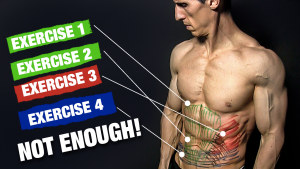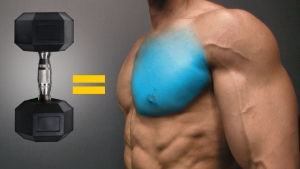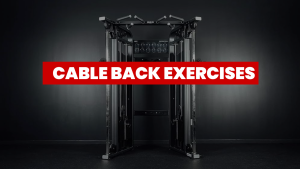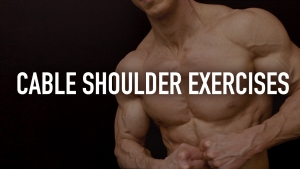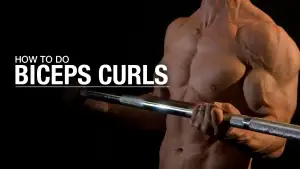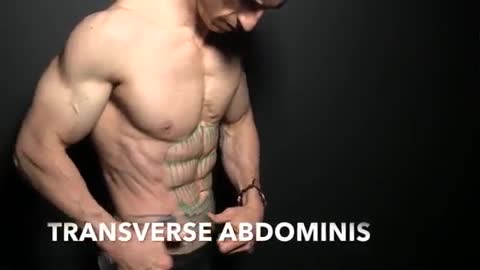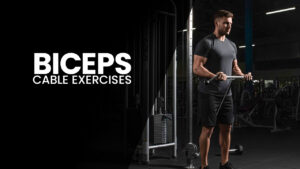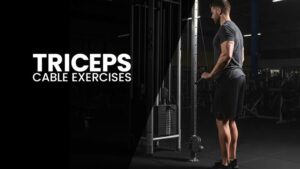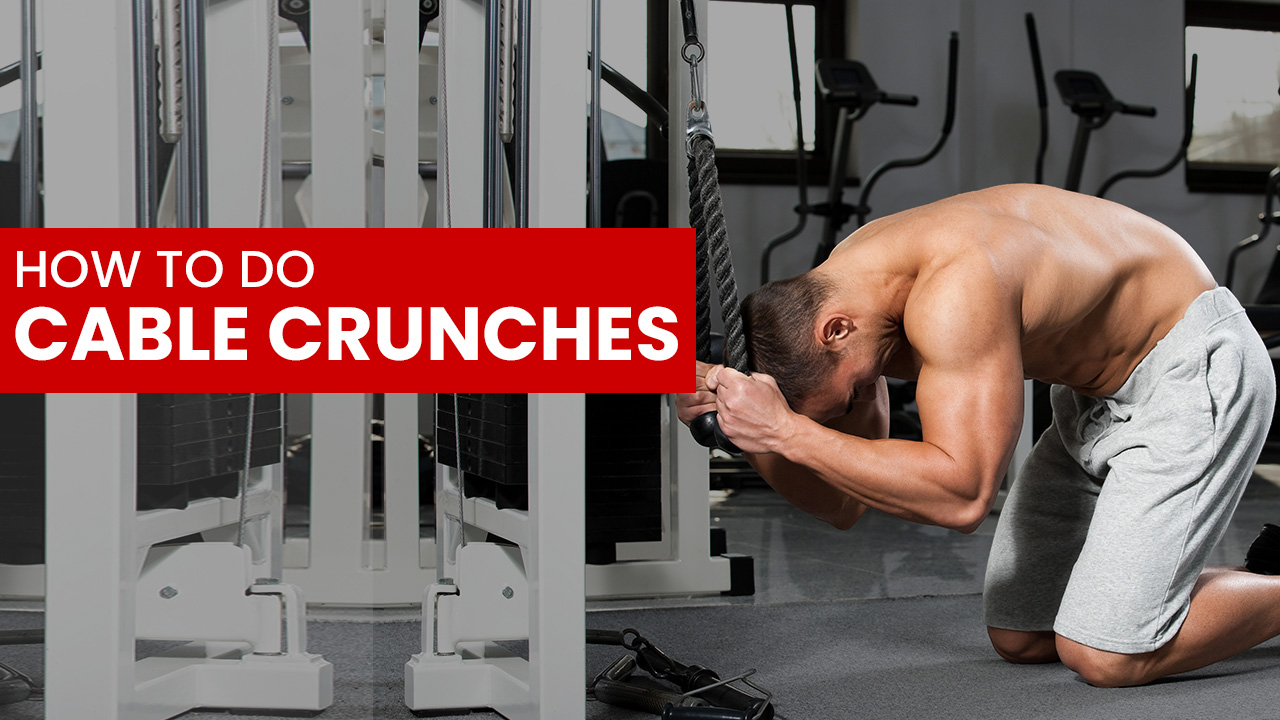
WHY do cable crunches?
Too many guys skip Cable Crunches.
Those who try often perform them so poorly that the hip flexors do all the work while the rectus abdominis and transverse abdominis sit idle.
Done correctly, the Kneeling Cable Crunch turns the cable machine and rope attachment into one of the most powerful tools for building abdominal muscles.
Unlike Sit Ups, Leg Raises, or Bicycle Crunches, the cable pulley provides constant resistance through every inch of the movement forcing your core to do the work.
Let’s take a closer look at the muscles worked during Cable Crunches, why they matter for core strength, and how to make sure you’re doing the exercise with perfect form.
CABLE CRUNCHES: MUSCLES WORKED
Too often, I see guys walk up to the cable machine, grab the rope attachment, and just butcher the movement, turning a great ab exercise into a glorified hip flexor workout.
If you want Cable Crunches to build your abs, you’ve got to train with intent.
This means locking in the mind-to-muscle connection. You want to feel the rectus abdominis shorten as you pull your ribcage toward your pelvis and keeping tension on the transverse abdominis as it braces.
At the same time, the obliques stabilize the movement instead of letting the hips take over.
The cable pulley gives you constant resistance, but it’s your intentional focus that makes each rep count.
Let’s break down the specific muscle groups you should be targeting, and what role each plays in getting the most out of Cable Crunches.
RECTUS ABDOMINIS
Located along the front of your torso, running vertically from the ribcage down to the pubic bone, the rectus abdominis is the muscle group that forms the “six-pack.”
Its main function is spinal flexion or bringing the ribcage toward the pelvis.
In a Kneeling Cable Crunch, the rectus abdominis does exactly that under load, which makes it one of the best abdominal exercises for building thickness and definition.
Unlike Sit Ups or Vertical Knee Raises, the cable rope attachment on the high pulley provides constant cable resistance, ensuring the rectus abdominis stays under tension throughout the entire range of motion.
TRANSVERSE ABDOMINIS (TRANSVERSUS ABDOMINIS)
The transversus abdominis lies deep beneath the rectus abdominis, wrapping around the midsection like a natural weight belt.
Its main role is bracing and stabilization. It compresses the abdominal cavity, supports the pelvic floor, and protects the spine.
During Cable Crunches, whether kneeling, standing, or even in variations like a Cable Crunch with isometric hold, this muscle group engages to keep your core locked in while the rectus abdominis flexes.
Without it, you’d risk collapsing forward or straining your lower back.
That’s why strength athletes and exercise professionals emphasize this muscle in functional training and even in back muscle solutions for lower back pain.
EXTERNAL OBLIQUES
Positioned on either side of the rectus abdominis, the external obliques run diagonally from the ribs down to the pelvis.
They’re responsible for trunk rotation, lateral flexion, and stabilization of the torso.
In the standard Kneeling Cable Crunch, they act as stabilizers, keeping your body aligned as you flex forward.
In variations like the Oblique Cable Crunch, Rotational Cable Crunch, or High-to-Low Cable Crunch, they become prime movers, powering rotational strength and carving out the lines that define your waist.
Add a Single-Handle Cable Crunch or Russian Twist, and you’ll feel just how much these muscles contribute to core performance.
HOW TO DO CABLE CRUNCHES
Cable Crunches don’t belong in the “optional ab exercises” section of the exercise libraries. They should be a staple for anyone serious about core strength.
Fitness enthusiasts often waste time with V Ups, Knee Tucks, or endless reps on the captain’s chair, but those moves can’t provide the progressive overload your abs need to grow.
Cable Crunches are different.
This is a true equipment-based weight-training exercise that lets you train your abs like every other muscle group.
Here’s how to do Cable Crunches:
CABLE CRUNCHES

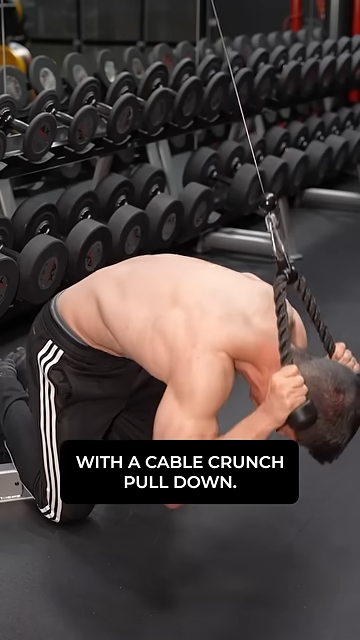
HOW TO DO CABLE CRUNCHES:
- Attach a rope cable to the high pulley of the cable machine. You can also use a straight bar or V-Bar Cable Crunch variation if that feels more natural. In a home gym, a resistance band anchored high can mimic the same setup.
- Kneel on the floor in front of the cable column (use a pad if needed). Grab the rope cable and hold it near your temples or shoulders. Keep your hips locked in place to avoid turning the movement into pure hip flexion.
- Curl your spine down slowly, pulling your ribcage toward your pelvis. Focus on contracting the rectus abdominis from the upper abdomen to the lower abdomen.
- Keep your arms fixed in place. They should simply hold the rope, not drive the motion.
- Resist the weight as you come back up. Don’t let the cable snap you upright.
- Keep tension on the abdominal muscles the entire time, just like you would with a Weighted Ab Crunch on an Ab Crunch machine or even when controlling a Medicine Ball Sit-Up.
- Exhale as you crunch down, tightening your core like you’re bracing for a kettlebell workout.
- Inhale as you return, keeping the erector spinae and pectoralis minor engaged for stability.
WHAT MAKES IT EFFECTIVE: What sets Cable Crunches apart is the constant tension from the cable stack. Unlike a weight bench Sit-Up, a Reverse Plank, or reps on an Ab Crunch machine, the cable keeps your abs working from start to finish. That means you can load the movement progressively, using the pin stack just like you’d track progress with a one rep max calculator for your big lifts.
multi-directional CABLE CRUNCHES


HOW TO DO MULTI-DIRECTIONAL CABLE CRUNCHES:
- Attach a rope cable to the high pulley of the cable machine. Kneel in front of the stack just like a Standard Cable Crunch. Grip the rope near your temples, keeping your elbows tucked in slightly.
- Perform the first crunch straight down (ribcage to pelvis) keeping your hips locked in place. This fires the rectus abdominis directly.
- Without resetting, crunch down toward your right knee. Keep the motion controlled, letting your obliques drive the rotation.
- Return to the start, then crunch down toward your left knee. That’s one full rep: straight, right, left.
- After completing the sequence, return to the starting position slowly. Don’t let the cable yank you back upright. Maintain tension in your core the entire time.
- Pro Tip: Think of “drawing a triangle” with your ribcage: down the middle, down to the right, down to the left. This keeps the focus on the abs instead of the hips or arms.
WHAT MAKES IT EFFECTIVE: The multi-directional cable crunch is like three ab exercises in one. The straight crunch overloads the rectus abdominis, while the side crunches torch the obliques with controlled rotation. Because all three directions are done back-to-back without releasing tension, your core has to stay braced continuously, building strength, stability, and endurance in a way standard crunches can’t match.
CABLE CRUNCHES: COMMON MISTAKES
Cable Crunches can be one of the most effective ab exercises you’ll ever do… or one of the biggest wastes of time.
It all comes down to execution.
Too many guys repeat the same errors over and over, turning a powerful equipment-based weight-training exercise into little more than hip flexion.
Let’s break down the mistakes holding most people back and how to fix them.
TURNING IT INTO A HIP HINGE
The most common error is unintentionally putting all the focus on the hips.
When you bend at the hips instead of curling your spine, your hip flexors dominate the exercise, and your abs barely get activated.
This is why so many people finish a set and feel it more in their lower back than in their core.
Lock your hips in place and think “ribs to pelvis.” The abs should shorten through spinal flexion, not hip flexion.
If you film yourself and it looks more like you’re nodding forward than curling, you’re doing it wrong.
USING TOO MUCH WEIGHT
It’s tempting to load the cable stack heavy but treating the exercise like you’re chasing numbers on a one rep max calculator completely defeats the purpose.
If you can’t control the rope, the rectus abdominis won’t stay under tension. It just turns into a momentum-driven move.
Some lifters even yank the cable so hard they turn it into a back exercise. Drop the ego.
Pick a weight you can control for 10 to 15 slow, deliberate reps. You’ll get more out of a moderate load with full contraction than a max stack “rep” that looks like a Squat combined with a Triceps Pushdown.
RUSHING THROUGH REPS
Cable Crunches aren’t cardio. Ripping through fast, sloppy reps removes tension from the abdominal muscles, which defeats the point of a Weighted Ab Crunch.
Think about it: if you did kettlebell workouts or squats this way, you’d never get stronger, so why would it work for your abs?
Use a controlled tempo. Two seconds down, slight pause at the bottom, two seconds back up. This forces your abs to stay under tension the whole time.
Remember, quality beats quantity here.
LETTING THE ARMS TAKE OVER
Another common issue: people pull the rope with their arms instead of locking them in place.
When that happens, the movement shifts to the arms, shoulders, and even the pectoralis minor, leaving the abs as bystanders.
You’ll know this is happening if your arms are smoked but your core feels fine.
Anchor your hands near your temples or collarbone and keep them locked there. Your arms are just hooks. The abs should drive the motion.
If you want an arm workout, do curls. Don’t steal from your abs here.
IGNORING PROPER SETUP
Bad setup ruins the exercise before you even start.
Standing too far from the cable column, grabbing the wrong attachment, or starting with your spine hyperextended all set you up for poor form.
The result is wasted reps, poor tension, and sometimes even back discomfort.
Kneel close to the stack, use the rope cable for the best range of motion, and start tall but neutral.
Whether you’re doing a kneeling version or a Standing Cable Crunch, the setup should feel stable before you move.
CABLE CRUNCHES: PROGRAMMING AND PROGRESSION
Your abs won’t grow just because you throw in a few sets of crunches at the end of a workout.
That’s the mistake most people make. They treat ab training as an afterthought.
Cable Crunches need to be programmed the same way you’d approach Squats, Bench Presses, or Deadlifts.
In other words, you need structure, progression, and a clear goal. Train them like a serious lift, and your abs will finally respond like any other muscle.
Here are some tips on how to program and progress your workouts with Cable Crunches:
WHERE TO PUT CABLE CRUNCHES
If Cable Crunches are the “meat” of your ab training, they deserve a spot at the beginning.
Doing them first ensures you’re fresh and can attack the movement with good form and heavier weight.
Think about it: you wouldn’t hit your heaviest Squat after burning yourself out with Lunges and Step-Ups so why do the same with your abs?
Another smart option is programming Cable Crunches after Squats, Deadlifts, or Bench Press.
Heavy compound lifts demand a braced core and following them up with direct ab work reinforces that stability.
It’s like telling your body, “The job isn’t over yet. Lock in that brace for next time.”
Done consistently, this not only builds stronger abs but also protects your lower back under load.
Even if you don’t have a commercial cable stack, you can still make Cable Crunches a staple.
A resistance band anchored high on a doorframe or rack mimics the same line of pull. It may not have the pin stack, but with creativity and progressive band tension, you can replicate the stimulus.
REP RANGES AND GOALS
Let’s break this up into the three most common goals for core training: muscle growth, performance strength, and endurance or conditioning.
When it comes to hypertrophy, for thicker, more visible abs, aim for 10 to 15 reps with a challenging load.
Move slowly and control the way down, pause hard at the bottom, then return under control.
Don’t just move the weight. Make the abs contract like you’re trying to shorten your torso.
If your goal is performance strength such as better bracing in lifts or more stability in sports, you should treat Cable Crunches like a true strength movement.
Work in the 6 to 8 rep range with heavier weight, focusing on quality over volume.
This approach trains your abs to handle real load, the same way you’d train any other major muscle group.
For athletes or fitness enthusiasts who need more work capacity, lighter weight with 15 to 20+ reps is the move.
This builds fatigue resistance, so your core won’t crumble late in a workout, a game, or a race.
Keep the tempo controlled. Don’t turn it into a speed contest. Endurance work should still be precise.
PROGRESSION STRATEGIES
Finally, here are some ways you can progress your core workouts with Cable Lateral Raises:
Add Load: The simplest way to progress is to gradually move the pin down the stack. But don’t fall into the trap of ego lifting. Loading too heavy turns this into a sloppy hip flexor drill. Increase the weight only when you can maintain perfect form through every rep.
Increase Time Under Tension: Slowing the tempo forces the abs to work harder. Try a 3-second descent, hold for 2 seconds at the bottom, then rise slowly. This adds intensity without touching the weight stack. It’s also a great plateau-buster.
Volume Manipulation: If you’re stuck, add more sets or reps. For example, move from 3×10 to 4×12. Small bumps in volume accumulate over time and drive growth without sacrificing form.
Frequency: Abs recover faster than bigger muscle groups, but that doesn’t mean you should hammer them every day. For weighted ab crunches, 2 to 3 times per week is ideal. Train them heavy, allow recovery, and come back stronger.
Most people waste years chasing ab “burns” without ever training their abs to grow.
Cable Crunches change that by letting you overload your core with the same intent you bring to your big lifts.
If you want results, stop chasing reps and start training your abs with purpose.
Check out our complete line of ATHLEAN-RX Supplements and find the best training program for you based on your fitness level and goals.

- The Cable Crunch is an excellent core training option because it lets you overload spinal flexion with constant resistance, forcing your abs to work through the entire range of motion the way they were built to function.
- Here’s how to perform the traditional Kneeling Cable Crunch:
- Attach a rope to the high pulley of the cable machine. If you’re training in a home gym without a cable machine, you can anchor a resistance band high to mimic the same setup.
- Kneel on the floor close to the cable column. Use a pad under your knees if you need extra support.
- Hold the rope near your temples or shoulders, and keep your hips locked in place. This ensures the movement stays in your abs and not in your hips.
- Curl your spine slowly, bringing your ribcage toward your pelvis. Think about your abs pulling you down rather than your arms dragging the rope.
- Resist the weight as you come back up. Don’t let the cable snap you upright. Keep the motion smooth and deliberate.
- Keep constant tension on your abs from start to finish.
- Exhale as you crunch down, bracing your core as if you’re preparing to take a punch. Inhale as you return to the top, keeping your entire torso tight and stable.
CABLE CRUNCHES FAQ
Absolutely. Cable Crunches are one of the most effective ab exercises because they let you train your abs under load, which is something most people never do.
Sit Ups, V Ups, or Knee Tucks will give you a burn, but they can’t provide the progressive overload needed for growth.
The cable stack solves that by giving you constant resistance throughout the entire range of motion.
That means your rectus abdominis and transverse abdominis are working from start to finish, not just at the top or bottom of the movement.
Done correctly, Cable Crunches build real thickness in the abs while also reinforcing the stability your core needs to protect the spine during Barbell Squats, Deadlifts, and overhead lifts like Barbell Shoulder Presses.
The key is to make the abs do the work, not your arms and not your hips.
Start by attaching a rope to the high pulley and kneeling close to the stack. Grab the rope near your temples, keep your hips fixed, and think “ribs to pelvis” as you curl your spine downward.
Don’t hinge at the hips or yank the cable with your arms. Your hands are just hooks holding the rope in place.
Exhale as you crunch down, pause for a second at peak contraction, then control the return back up.
Keep your abs engaged the entire time, and you’ll feel the difference immediately.
If you don’t feel your abs firing after the first rep, stop and reset. Remember that this is a spinal flexion exercise, not a hip flexion exercise.
Facing the stack is the gold standard. That’s the classic Kneeling Cable Crunch, and it’s the version that gives you the best range of motion and constant tension.
That said, facing away from the stack has its place, especially in standing variations.
When you face away, the resistance line changes, forcing your core to stabilize differently and giving the obliques a bit more involvement.
If your goal is maximum rectus abdominis development, stick with facing the stack.
If you want to mix things up for variety or add a Standing Cable Crunch to target stability and control, facing away can be a smart addition.
But don’t confuse variety with necessity. The classic setup is still king.
REFERENCES
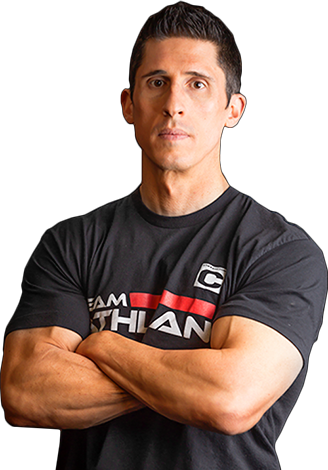
Jeff Cavaliere M.S.P.T, CSCS
Jeff Cavaliere is a Physical Therapist, Strength Coach and creator of the ATHLEAN-X Training Programs and ATHLEAN-Rx Supplements. He has a Masters in Physical Therapy (MSPT) and has worked as Head Physical Therapist for the New York Mets, as well as training many elite professional athletes in Major League Baseball, NFL, MMA and professional wrestling. His programs produce “next level” achievements in muscle size, strength and performance for professional athletes and anyone looking to build a muscular athletic physique.



